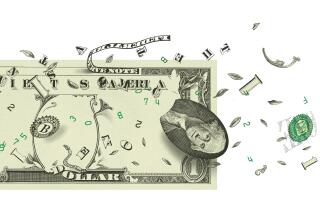1995-96 REVIEW AND OUTLOOK : Countdown to a New Millennium : For 1996, Fair Winds Are Still Blowing
- Share via
It would be helpful if the economic outlook at the start of every year came equipped with a You Are Here arrow. To see where you’re going, it’s good to know the starting point.
Heading into 1996, there is an undercurrent of deflation in the economy. That means falling prices, as distinct from disinflation, which is the slowing of the rise in prices.
The U.S. economy exhibits both tendencies at this new year, and that’s why interest rates will be easing downward--getting as low as 5.25% on the benchmark 30-year Treasury bond, experts say.
Low interest rates can be a spur to business activity, of course. Investors were betting at the end of the year that with the economy slow the Federal Reserve would continue reducing interest rates. Those expectations in turn buoyed the stock market, which continues to hover in the stratosphere--although nervously.
Investor anxiety recognizes that falling prices can also mean suffering for businesses and even consumers, if they owe money in a time when it’s difficult to charge customers more or get a pay raise.
The outlook therefore is for an economy--and stock market--subject to some accidents and reverses, but one that will achieve fair, 2.5% growth and continue to work out the disinflationary dynamic that has characterized U.S. business, financial and political affairs for more than a decade.
Deflation is not always visible. But appliance warehouses that ask for no payments until mid-1996 or even ’97 are reducing prices; wage freezes and cuts in benefits are deflationary.
And merchandise everywhere is in oversupply, says an Orange County retailing consultant who was offered a consignment of bluejeans at $1.75 a pair if he could move the stuff into retail outlets.
Meanwhile, the rest of the world’s economies, which mean more every day to U.S. workers and consumers, are trying to follow the U.S. lead--Japan to reform a sclerotic system, Germany and Western Europe to reduce bloated budgets, and the developing countries of Asia and Latin America to provide growth markets no longer available in advanced countries.
But this is not the 1930s. Deflation doesn’t mean recession. Most 1996 predictions are for a slowly growing but not a weak economy.
Truth is, the U.S. economy may not need rapid growth these days. Charles Clough, chief investment strategist for Merrill Lynch, points out that the labor force is growing only 1% a year, one-third the pace of the 1970s, so the economy doesn’t need to create as many jobs. (The 5.4% unemployment rate is a different issue, reflecting the many people who need education and special help before they can get a job.)
The economy reflects the shifting priorities of an aging population. That’s one reason retail sales at Christmas, particularly in apparel stores, were a disaster. But restaurants offering traditional fare, such as the Boston Market chain, are doing well across the country.
The aging population is behind the push for a balanced budget and at the forefront of the fight over Medicare funding. But the conclusion of that fight on Medicare is known: It will end with cuts to prevent the health care program from running huge deficits into the next century.
The issues in today’s debates over Medicare and budgets were decided, in effect, in the 1980 election in which Americans voted to stop inflation. Voters then said they would tolerate more unemployment rather than more inflation. So the new Reagan administration and the Federal Reserve under Chairman Paul Volcker tightened money, threw the economy into recession and broke the inflation fever.
*
That was a turning point, a recognition by the American people that the expensive promises made in the economy of the 1960s, even as capital poured away in Vietnam, could not be afforded on slower growth.
Investors in 1982, sensing that realistic decision, sent the stock market off on the still-running, longest bull market in history.
And it’s predictable that the current budget debate will conclude with an agreement to cut back government services and balance the federal budget. Markets will rejoice. “If they get a credible budget agreement, it will inspire the bond markets,” says economist Sung Won Sohn of Norwest Corp., the Minneapolis-based banking company.
Stocks will also do well, says economist Paul Boltz, of the T. Rowe Price mutual fund organization, who thinks the economy is stronger than the consensus believes. But Boltz, too, says that much is riding on the budget balancing agreement.
Budget cutting has become a worldwide phenomenon because the industrial nations realize not only that they can’t afford today’s social benefits but that awesome pension liabilities will bankrupt their treasuries unless something is done.
By the year 2000, one in six Japanese will be over 65--compared to one in eight Americans. But the United States has been funding its future pension liabilities much more than other countries have, according to the Paris-based Organization for Economic Cooperation and Development.
As a result, Germany, France, Italy, Japan and other countries face enormous burdens, says a report by Salomon Brothers, the investment firm. But as those nations alter pension systems and revise budget obligations--as France so publicly has been trying to do--the effect will be to cut back inflated purchasing power in their economies.
*
Aging populations, pension obligations, cutbacks in benefits--all are factors feeding the deflationary trend in advanced economies.
These trends are inexorable, and those who don’t recognize them--whether business people or investors or workers--can be hurt. The tale of two U.S. labor strikes that ended in December tell a revealing story.
On Dec. 4, the United Auto Workers ignominiously ended a 17-month strike and a four-year labor dispute at Caterpillar Inc. of Peoria, Ill., by accepting the company’s terms.
Initially the dispute was over work rules and other changes Caterpillar said it needed to compete in the global economy. The union refused to accommodate such requests, went on strike and lost when Caterpillar ran its plants with replacement workers and supervisory personnel.
But in a strike at Seattle-based Boeing Inc., George Kourpias, the leader of the Machinists and Aerospace Workers, took a different tack. Kourpias reckoned the real issue was Boeing’s need to subcontract work to countries that buy its airplanes, a need the machinists could accommodate if they had a say in the subcontracting.
So as part of his bargaining, Kourpias went to President Clinton and put the argument over U.S. workers and the global economy into a political context. The tactic worked. The machinists won the right of consultation while recognizing Boeing’s need--and the workers’ need--to compete in the global economy.
It was an intelligent settlement and may have set the tone for many to come as U.S. workers, whether union or non, demand to be consulted about changes in the global economy that affect them.
Like the machinists’ Kourpias, most Americans realize the global economy is where we now make our living--and not in the traditional markets of Europe and Japan either.
The developing countries of Asia, Latin America and Africa are increasingly important for our products, notes economist Stephen Roach of Morgan Stanley, who predicts strongly growing U.S. exports in 1996.
*
They’re the places doing work we no longer need to do. For example, Malaysia is building a semiconductor plant in Sarawak for $1.2 billion, which is about the cost of such a plant in Phoenix or Albuquerque.
But in Sarawak there is also a need for $1.8 billion worth of infrastructure--roads, power plants, water systems--to be built. That infrastructure represents the growth in the world economy; it is not inflationary but productive, and it promises business for skilled companies of the United States and other countries.
To be sure, the world economy can be a perilous place. The global financial system currently trades $1 trillion in currencies and securities every day. “What I fear in such an environment are accidents,” says Joan Payden, president of Payden & Rygel, a Los Angeles fixed-income investment management firm. In a time of low U.S. interest rates, investors may try for extra gains by playing foreign bonds against U.S. Treasuries and so forth. Accidents, as the world learned in 1994 from global bond markets and Orange County, can shake confidence.
Still, Payden, who says “we were early in the disinflation-deflation camp,” predicts a “neat bond market” in 1996 with double digit returns possible.
You can make confident assessments about the new year, if you know the trends on which it begins.
More to Read
Inside the business of entertainment
The Wide Shot brings you news, analysis and insights on everything from streaming wars to production — and what it all means for the future.
You may occasionally receive promotional content from the Los Angeles Times.










